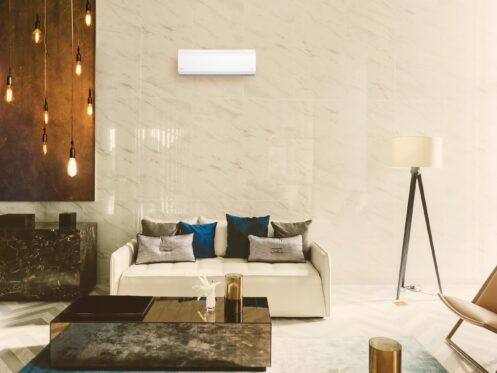If you are looking for an efficient and flexible heating and cooling option for your home, consider a ductless mini-split. Here’s everything you should know about this system, including areas in which it excels over traditional HVAC systems.
Understanding a Ductless Mini-split
A ductless mini-split is an HVAC system with the same outdoor and indoor units that work together to control indoor temperatures. However, unlike central AC, it doesn’t use a ductwork system to distribute air, and the indoor units can be as many as the number of rooms in your home.
How They Work
The outdoor unit of a ductless mini-split is the compressor or condenser. The indoor component is an air handler, which contains air filters, fans, and evaporator coils. These two units are connected by a conduit that houses a condensation drain line, refrigerant and suction tubing, and power and communication cables.
Mini-splits have a special liquid called refrigerant that travels back and forth between the outdoor and indoor units. At start-up, the refrigerant is in an ice-cold liquid state.
When you set your thermostat to cooling mode, the air handler (indoor unit) uses its fans to pull in all the air in your room. This air passes through air filters that trap dust, water vapor, and other particles before it reaches evaporator coils.
The evaporator coils contain the refrigerant in its cold, low-pressure liquid state. The cold refrigerant liquid absorbs the heat in the warm air passing over the evaporator coils, significantly lowering its temperature. The fan motors then push the cold, conditioned air back into your room.
After absorbing that heat, the refrigerant gets hot and highly pressurized. In fact, the heat changes its state to a gas (vapor).
The condenser pulls the vaporized refrigerant via its designated tubing in the conduit. Here, it releases that heat outside while circulating inside the condenser coils. The outdoor unit also contains a fan that blows air over the coils to facilitate the refrigerant cooling process.
Once cooled, the refrigerant reverts to its low-pressurized liquid state. The condenser will send it back to the indoor unit to absorb more heat from the warm air and dispose of it outside. This process continues until the room’s indoor air temperature is cold enough to match the targeted thermostat temperatures.
Ductless mini-splits can also warm your room by reversing the above process. In home heating mode, the outdoor unit compresses the refrigerant to make it hot and then pumps it to the indoor unit. The hot refrigerant transfers its heat to the indoor air passing over the evaporator coils, raising the temperature to the occupants’ desired comfort levels.
Types of Ductless Mini-splits
You can configure your ductless mini-split to have either one or multiple indoor units. There are two main types available:
Single-zone Mini-splits
Your HVAC technician can install your system such that one indoor unit corresponds to one outdoor compressor. This is a good option if you just want to control the temperature in a single room or area, such as a home office, bedroom, or basement.
Multi-zone Mini-splits
Multi-zone mini-splits allow homeowners to simultaneously cool or warm multiple rooms or areas (zones) within the house. It has one outdoor unit connected to several indoor units.
Every zone will have its own thermostat to allow for customized temperature control. This means you can set your room temperature to 60 degrees Fahrenheit while the person in the next room can set theirs to 68 degrees Fahrenheit.
5 Benefits of Ductless Mini-splits
Ductless mini-splits have numerous advantages over other types of air conditioners. They include:
1. Efficiency
Ducts can lose up to 40% of the heating or cooling energy put out by the HVAC system. This often occurs due to leaks, poor insulation, and the distance the conditioned air has to travel.
Since mini-splits are ductless, you will avoid these losses, saving significantly on energy bills. Also, since you can zone your system, you’ll only warm or cool the areas of your home you are occupying, avoiding energy wastage.
2. Two Appliances for the Price of One
Ductless mini-splits can function both as an AC and a heater using a heat pump system. They can cool and heat a home as efficiently and effectively as conventional systems.
The best part is that mini-splits transfer heat from one area to another. For instance, in heating mode, they use the refrigerant to absorb heat from the outdoor air and then dissipate it indoors. Not generating heat from scratch like furnaces do makes them up to four times more efficient and reliable.
3. High-Quality Indoor Air
Just as ducts contribute to significant energy losses, they can also be a great source of indoor air pollution. When they have leaks, the surrounding air tends to mix with conditioned air before being delivered to your rooms. This not only pollutes the indoor air but also puts a lot of strain on the filters. Ducts also tend to harbor microorganisms and rodents, which can also pollute the air.
On the other hand, ductless mini-splits condition and clean air at the indoor air unit. As long as your air filters are in good condition and you practice overall home hygiene, you may never experience air quality issues.
4. Interior Design Flexibility
Since mini-splits don’t require a duct network, you can install the indoor unit in whichever area you like in your home. You can have it on the wall, ceiling, or even freestanding on the floor, as long as its setup seamlessly blends into your room’s aesthetics and décor.
5. Easier Advanced Tech Integration
Ductless mini-splits are still relatively new on the market. This means they were built with modern home technology in mind. You can effortlessly integrate advanced devices that enhance convenience and control, such as voice assistants, smart thermostats, and motion sensors.
Considerations When Looking for a Ductless Mini-split
Even though ductless mini-splits offer great flexibility and a simplified installation process, you must keep in mind a few critical factors to ensure peak efficiency and effectiveness. They include:
Proper Sizing
You need to consult with a qualified HVAC technician to determine the correct mini-split size for all your individual rooms. “Sizing” in air conditioning refers to the amount of cooling or heating a system can provide within a specific amount of time, usually an hour. The metric used for this measurement is British thermal units (BTUs).
An undersized system will be inefficient and less effective. It will constantly run to keep up with the room’s heating or cooling needs. This results in faster degradation of parts and energy wastage.
On the other hand, an oversized system, which comes at a more significant upfront cost, will short cycle. This means that it will repeatedly and prematurely turn on and off, creating hot and cold spots in the room.
The Seasonal Energy Efficiency Ratio (SEER) Rating
The SEER rating is a metric used to determine how efficient a mini-split is at cooling. It’s calculated by evaluating the system’s cooling output in relation to the energy it consumes over a predetermined season. Mini-splits with high cooling capacity and low energy consumption are very efficient and effective, and they are rated highly.
Do You Need More Information?
Schedule an appointment with Marr's Heating, AC, Plumbing and Electrical in Bellingham, WA, to learn more about ductless mini-splits. Our qualified technicians can help you choose the best type and size for your home and install it for you. We also offer indoor air quality solutions, smart thermostat integration, and system maintenance.



